
A collection of 101 research writing idea prompts.
- Subject:
- English Language Arts
- Material Type:
- Activity/Lab
- Provider:
- E Reading Worksheets
- Author:
- E Reading Worksheets
- Date Added:
- 02/26/2019

A collection of 101 research writing idea prompts.

Students learn useful, reliable ways to locate materials for personal, academic or professional research projects on NYTimes.com.

Students work collaboratively to research and record information about different spinoffs of space exploration. Using the information they find, students then write a script to be produced into a podcast or vodcast.

This resource accompanies our Rethink 6th Grade ELA course. It includes ideas for use, ways to support exceptional children, ways to extend learning, digital resources and tools, tips for supporting English Language Learners and students with visual and hearing impairments. There are also ideas for offline learning.

This parent guide supports parents in helping their child at home with the 6th grade English Language Arts content.
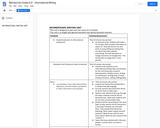
Students will learn the components of an informational essay. Through modeling, mini-lessons and multiple opportunities for practice and feedback, students will go through the writing process to produce an informational essay on the topic of their choice.
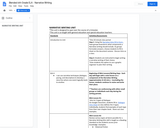
Students will learn the components of a Narrative writing. Through mini-lessons (Ex: dialogue, story elements, figurative language, good introductions,genre study, etc.), daily writing and revising, students will go through the writing process to produce a narrative writing on a topic of their choice.

The Adventurers of Sojourner presents a third-person narrative account of the Mars Pathfinder mission, which included the deployment of a small science rover named Sojourner. In this CCSS lesson, students will explore this history through text dependent questions, academic vocabulary, and writing assignments.

Students will research an African American person based on set questions. The students will present their person in an interview format - Guess Who.
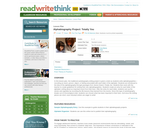
In this lesson plan, the traditional autobiography writing project is given a twist as students write alphabiographies—recording an event, person, object, or feeling associated with each letter of the alphabet. Students are introduced to the idea of the alphabiography through passages from James Howe's Totally Joe. Students then work with the teacher to create guidelines for writing their own alphabiographies. Students create an entry for each letter of the alphabet, writing about an important event from their lives. After the entry for each letter, students sum up the stories and vignettes by recording the life lessons they learned from the events. Since this type of autobiography breaks out of chronological order, students can choose what has been important in their lives. And since the writing pieces are short, even reluctant writers are eager to write!

In this lesson, students will compare/contrast the information in their textbook about Andrew Jackson to political cartoons of the era. Students will identify symbols, allusions and stereotypes used in these cartoons and infer the intended message and tone of the Jackson era cartoons. Students will also identify any biases in the cartoons and check for historical accuracy, and then formulate their own opinion about the Jackson Administration. As a culminating activity, students will write an opinion essay that articulates their personal stance on Andrew Jackson’s character, using proper writing conventions.

In this activity, students will work in collaborative groups to create 9M x 9M models of plant and animal cells. Class population can be split into 2 or 4 groups, with half the students constructing animal cells and the other half constructing plant cells. Students must organize and assign duties, provide materials for this activity, and write a written report. They will also give "Cell Tours" to other students and/or classroom guests.
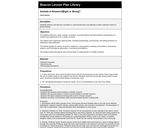
Students will research and discuss a sensitive or controversial issue and attempt to make a decision based on group findings.
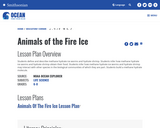
Students learn about methane hydrate ice worms and hydrate shrimp, including how they obtain their food and interact with other species in deep sea ecosystems. Students will work in collaborative groups to research these organisms to develop hypotheses about the relationship between methane hydrates, ice worms, and hydrate shrimp and present their hypotheses to the class. In an extension activity, students will construct models of methane hydrate molecules.

After reading haikus and examining the haiku format in this lesson, students write their own haikus that they then animate using Animoto.
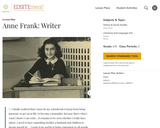
This lesson concentrates on Anne Frank as a writer. After a look at Anne Frank the adolescent, and a consideration of how the experiences of growing up shaped her composition of the Diary, students explore some of the writing techniques Anne invented for herself and practice those techniques with material drawn from their own lives.
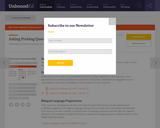
In this lesson, students will be introduced to research topics, and by the end of the lesson they will choose a topic for their own research.
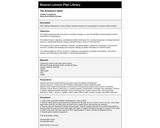
In this lesson, students read Shakespeare's "Julius Caesar", then research the assassination of another historical figure.
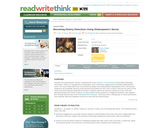
Students use Shakespeare's Secret, a featured title on the Teachers' Choices Booklist (International Reading Association, 2006), as a springboard to exploration of the controversy regarding the authorship Shakespeare's works. The novel makes liberal use of the historical details surrounding William Shakespeare's life, and exposes students to the possibility raised by some theorists that Edward de Vere, Earl of Oxford, was the true author of the works that have long been attributed to the Bard. Students explore the historical references in the novel and generate questions for further research. As they research these questions on suggested websites, they organize their findings with the help of the ReadWriteThink Notetaker. Then they work in small groups to create and present short dramatic skits that creatively connect the novel with the historical facts.

Students conduct research about how studying ocean currents is helpful to people in specific jobs or professions. Then they present their findings to the class.